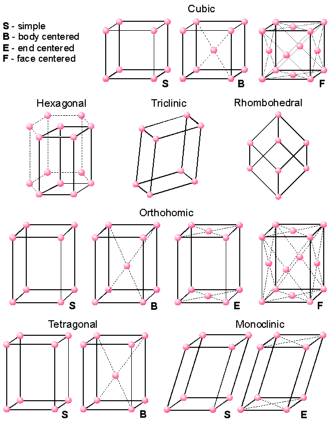 The smallest repeating unit in a crystal is called the unit cell. The geometry and the position of the particles within the unit cell determine the structure of crystalline materials. Three edge lengths (a, b, c) and internal angles (a, b, g) will be used to describe the geometry of a unit cell. There are seven crystal systems and fourteen possible unit cells (Bravais unit cells) depending on the values of a, b, c and a, b, g.
The smallest repeating unit in a crystal is called the unit cell. The geometry and the position of the particles within the unit cell determine the structure of crystalline materials. Three edge lengths (a, b, c) and internal angles (a, b, g) will be used to describe the geometry of a unit cell. There are seven crystal systems and fourteen possible unit cells (Bravais unit cells) depending on the values of a, b, c and a, b, g.

Some of the particles within a unit cell may be shared and therefore do not belong completely to an individual cell. Therefore, in order to calculate number of particles per unit cell we have to consider the following contributions for each particle according to its position:
- atoms centered on the face count 1/2;
- atoms centered on the edge count 1/4;
- atoms centered on the vertex count 1/8
In a simple cubic number of atoms per unit cell = 1; in a body centered cubic - 2; in a face centered cubic - 4.
Atomic packing factor = (Volume of atoms)/(Volume of unit cell). For a simple cubic - atomic packing factor = 0.52; a body centered cubic - 0.68; a face centered cubic - 0.74
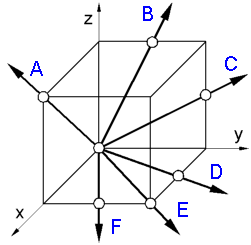 To determine a crystallographic direction [uvw] in a unit cell:
To determine a crystallographic direction [uvw] in a unit cell:
1. Find the vector projections on the three axes.
A - 1,0,1; B - 0,1/2,1; C - 0,1,1/2;
D - 1/2,1,0; E - 1,1,0; F - 1,1/2,0.
2. Reduce these coordinates to the 3 smallest integers having the same ratio.
A - [101]; B - [012]; C - [021];
D - [120]; E - [110]; F - [210].
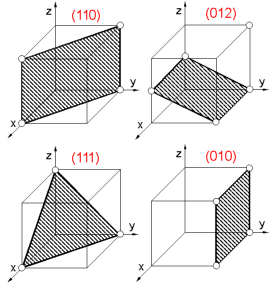 A plane within a crystal is defined by the Miller indices. To determine crystallographic (Miller) indices (hkl) of the plane:
A plane within a crystal is defined by the Miller indices. To determine crystallographic (Miller) indices (hkl) of the plane:
1. Find intercepts of a plane on the three axes in terms of the unit cell dimensions.
2. Determine the reciprocals of these numbers.
3. Reduce the reciprocals to the three smallest integers.
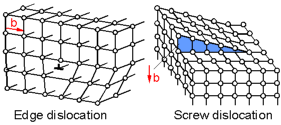 There are two main types of planar defects called dislocations - edge dislocation and screw dislocation. A dislocation is a sharp change in the order of atoms along a line. Dislocations move on the slip plane. The magnitude and direction of the slip is defined by the Burger's vector, b. For an edge dislocation the direction of slip is perpendicular to the direction of the dislocation. For a screw dislocation the direction of slip is parallel to the direction of the dislocation.
There are two main types of planar defects called dislocations - edge dislocation and screw dislocation. A dislocation is a sharp change in the order of atoms along a line. Dislocations move on the slip plane. The magnitude and direction of the slip is defined by the Burger's vector, b. For an edge dislocation the direction of slip is perpendicular to the direction of the dislocation. For a screw dislocation the direction of slip is parallel to the direction of the dislocation.
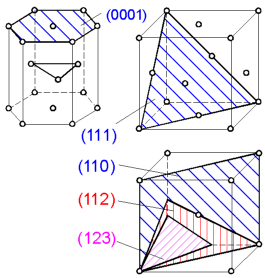 Slip is known to occur on planes (shown on the picture) in the direction of the maximum density of atoms. This is called a slip system. If there are many slip systems then deformation can occur relatively easily and the metal is considered ductile. BCC crystal structure has up to 48 slip systems. FCC crystal structure has 12 slip systems. HCP crystal structures have only 3 slip systems. Accordingly, most metals with a HCP crystal structure (Mg, Zn, Be) are less ductile than metals with a BCC (W, Fe, K) or FCC (Cu, Al, Ni) structure.
Slip is known to occur on planes (shown on the picture) in the direction of the maximum density of atoms. This is called a slip system. If there are many slip systems then deformation can occur relatively easily and the metal is considered ductile. BCC crystal structure has up to 48 slip systems. FCC crystal structure has 12 slip systems. HCP crystal structures have only 3 slip systems. Accordingly, most metals with a HCP crystal structure (Mg, Zn, Be) are less ductile than metals with a BCC (W, Fe, K) or FCC (Cu, Al, Ni) structure.
The distance between atoms varies depending on the crystallographic directions. This is the cause of the anisotropy of mechanical and physical properties of a crystal. Therefore, samples cut from a monocrystal in different directions will exhibit a difference in the stiffness. In the FCC and BCC crystals of metals the highest elastic modulus is found in [111] direction, while the lowest is found in the direction of [100]. Real materials consist of many chaotically oriented monocrystals, which results in the isotropy of their properties.
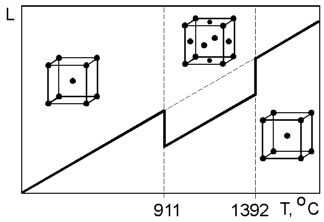 Some materials can exist with different crystal structures. This can be demonstrated by pure iron which has a body centered cubic (BCC) structure at room temperature and a face centered cubic (FCC) structure at 911 oC. This change is accompanied by shrinkage in volume due to the FCC structure being more closely packed than the BCC structure. The second transformation of crystal structure from FCC to BCC occurs at 1392 oC.
Some materials can exist with different crystal structures. This can be demonstrated by pure iron which has a body centered cubic (BCC) structure at room temperature and a face centered cubic (FCC) structure at 911 oC. This change is accompanied by shrinkage in volume due to the FCC structure being more closely packed than the BCC structure. The second transformation of crystal structure from FCC to BCC occurs at 1392 oC.
 2015-08-13
2015-08-13 470
470








